What is Vaulted Ceiling?
A vaulted ceiling slopes up toward the roof and extends higher than average flat ceilings’ typical eight to ten-foot height. Arched, barrel, cathedral, domed, groin, and rib are some of the most popular vaulted ceilings, each with its structure. Originally used to designate ceilings with a self-supporting arch in classical architectural design, the word “vaulted ceiling” is now commonly used to describe any sloped, high ceiling.
During the middle ages, vaulted ceilings were a significant element of Gothic and Roman churches and basilicas (public buildings). Still, over time, they progressively became the ceilings of some traditional, modern, and industrial-style dwellings. A vaulted ceiling differs from other types of ceilings in that it extends from the building’s side walls to the central point, creating a great volume of overhead space.
Types of Vaulted Ceilings:
1. Dome Vaulted Ceilings:
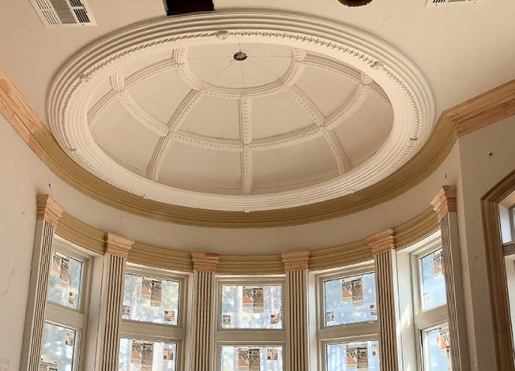
Fig 1: Dome Vaulted Ceilings
Courtesy: thoughtco.com
In master bathrooms and studies, dome vaults are common. This vault’s name perfectly sums up what it looks like. It is a dome that is recessed into your normal ceiling. It’s particularly popular in entryways and other small places because it creates the illusion of a domed ceiling. Although a domed ceiling is conceivable, it becomes increasingly difficult as the rooms grow larger.
2. Oval Dome Vaulted Ceiling:
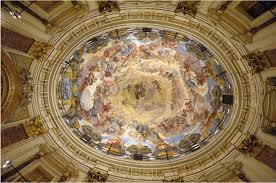
Fig 2: Oval Dome Vaulted Ceilings
Courtesy: structurae.net
At first appearance, oval domes appear similar to elongated dome ceilings. The fundamental distinction is the dome tie is used to fasten the rafters that shape the dome. Instead of the elongated dome ties used for the vaulted ceiling, oval ceiling dome ties are oval-shaped. The circular dome vaulted ceiling in the area below attracts the attention upwards and makes the space appear larger.
3. Elongated Dome Vaulted Ceiling:
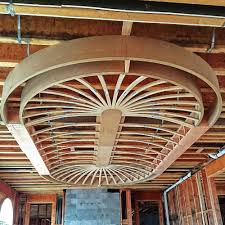
Fig 3: Elongated Dome Vaulted Ceilings
Courtesy: archwaysandceiling.com
An elongated dome ceiling may be just what you need to maximize your space, especially in a rectangular room. As the name implies, an extended dome ceiling is a longer or oval variant of a dome vaulted ceiling. The cloudy night sky-inspired painting inside the elongated dome vaulted ceiling in the picture below lends an aesthetic touch to the room.
4. Barrel Vaulted Ceilings:
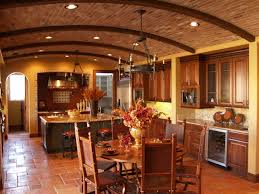
Fig 4: Barrel Vaulted Ceilings
Courtesy: houzz.com
A barrel vault is a type of arched ceiling with a single curve that runs the length of the ceiling. See how the barrel vault ceiling softens the foyer’s look and how the various glass panels let in plenty of natural light throughout the day in this photograph.
The barrel-vaulted ceiling is one of the most expensive vaulted ceilings because it necessitates skilled labor, raising the project’s overall cost.
5. Groin Vaulted Ceilings:
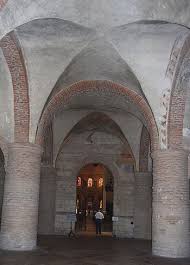
Fig 5: Groin Vaulted Ceilings
Courtesy: study.com
A Vaulted Groin The ceilings are made out of two-barrel vaults intersecting. The groined ceiling is created in a square with a point in the center of the ceiling space. The groin is between the intersecting locations where the remaining edges meet.
6. Rib Vaulted Ceilings:
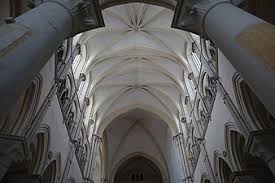
Fig 6: Rib Vaulted Ceilings
Courtesy: en.wikipedia.org
The Rib vaulted ceiling gave more versatility in engineering walls and roofing in gothic periods. The Rib vaulted ceiling is more flexible, stronger, and easier to construct than other vaulted ceilings. Rib vaulted ceilings provide thinner and more revealing walls and are more durable than other ceilings. It makes them perfect for Gothic construction, and the Rib vaulted ceiling of this cathedral ceiling adds a dramatic touch.
7. Fan Vaulted Ceiling:
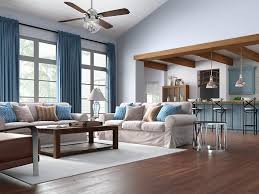
Fig 7: Fan Vaulted Ceilings
Courtesy: en.wikipedia.org
Fan vaulted ceilings are identical to rib vaulted ceilings, except smaller ribs spaced evenly. The beam is supported throughout the length of the ceilings by fan-vaulted ceilings. The fan-vaulted ceiling is one of the most expansive vaulted ceilings because it necessitates skilled labor, raising the project’s overall cost.
8. Pitched Brick Vaulted Ceilings:
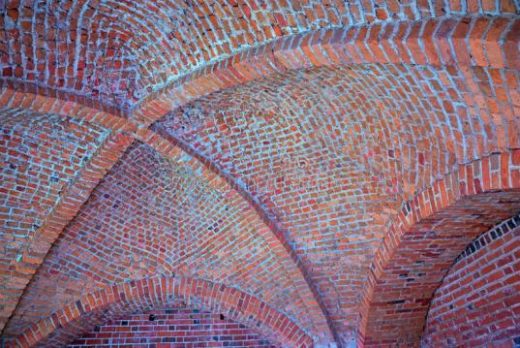
Fig 8: Pitched Brick Vaulted Ceilings
Courtesy: dreamstime/com
A pitched brick vault ceiling, also known as a diagonal brick approach, can give your home an urban feel. The pitched brick vault ceiling design can be traced back to Mesopotamian architecture from the first millennium B.C. Its non-centered design is still popular. In the picture below, the pitched brick vaulted ceiling in the picture below lends a sophisticated touch to this country farmhouse kitchen by creating a warm contrast with the bland room.
9. Cove Vaulted Ceilings:
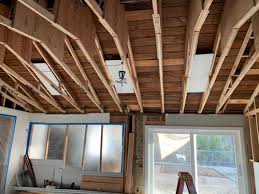
Fig 9: Cove Vaulted Ceilings
Courtesy: houzz.com
A cove ceiling may be the key to softening your area’s overall aesthetic. By smoothing out the corners and edges of your ceiling, cove ceilings may give your area a sleek, sophisticated aesthetic. The living area has a modern, streamlined aspect.
10. Cloister Vaulted Ceiling:
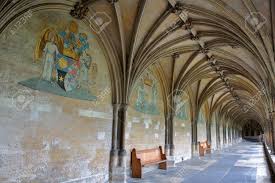
Fig 10: Cloister Vaulted Ceilings
Courtesy: 123rf.com
Cloister vaulted ceilings are defined as building ceilings that have multiple spring points or spring lines. The point where an arch begins to bend is known as the spring point, and all arching springs are built on the same center points along a wall.
11. Igloo Vaulted Ceiling:
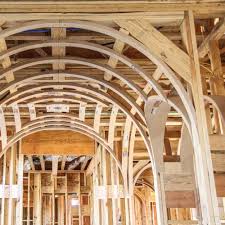
Fig 11: Igloo Vaulted Ceilings
Courtesy: archwaysandceiling.com
Igloo vaulted ceilings, also called lunette vaulted ceilings, are barrel-vaulted ceilings with carved-out arches. In Igloo, vaulted ceiling windows or other things are placed beneath them. Exaggerated instances of this ceiling type can be seen in the vaulted igloo ceiling.
Advantages of Vaulted Ceiling:
- Because it draws the eye upward in a room, a vaulted type ceiling creates additional visible space.
- The vaulted ceiling provided an additional surface area for opposing windows.
- However, some homeowners can use the vaulted ceiling to add a skylight to the ceiling, which benefits the vaulted ceiling.
- This visual space is beneficial for smaller floor plans since the vaulted ceiling can generate an illusion in a vast room.
- Another benefit of a vaulted ceiling is that it can be used as a design focal point.
- Few designers employ this vaulted ceiling as a dining room, living room, or family room.
- Consider a vaulted ceiling design if you want to give your home a gentle look.
Disadvantages of Vaulted Ceiling:
- The biggest downside of a vaulted ceiling design is that it consumes a lot of energy and necessitates additional air-conditioning costs to keep the space cool.
- Another disadvantage is the absence of warmth in lofty spaces with vaulted ceilings. As a result, as in this example, wood accents and warm color tones can inject a sense of coziness.
- The exposed beams are difficult to keep and clean because of the vaulted ceilings’ height (if any). Painting the ceiling and changing the light bulbs or fixtures are also tough.
- Construction costs are higher with vaulted ceilings.
- Vaulted ceilings, especially in damp areas like the bathroom and kitchen, can cause condensation on tall windows and mold formation.
Conclusion:
Additional ceiling height or shape may appear beneficial. Still, when done incorrectly, the ceiling feature can make a space feel unresolved, and the ceiling detail can even make a space feel smaller, not greater. Vaulted ceilings are a significant investment that should consider the rest of your home’s construction. Expect a rise in your energy bill if you buy a home with vaulted ceilings. Overall, you should go for it if you genuinely adore the style. Vaulted ceilings are a certain method to add flair to a home while also creating an open, airy, and light-filled environment.
References:
1. Tonelli, L. (2020, 0 16). Are Vaulted Ceilings the Greatest Home Design Idea? ELLE Decor; www.elledecor.com. https://www.elledecor.com/design-decorate/interior-designers/a30520060/vaulted-ceilings/
2. The Ultimate Guide to Vaulted Ceilings. (n.d.). Houzz; www.houzz.in. Retrieved March 14, 2022, from https://www.houzz.in/magazine/the-ultimate-guide-to-vaulted-ceilings-stsetivw-vs~148998920
3. 14 Types Of Vaulted Ceilings You Should Know – Home Decor Bliss. (2021, March 21). Home Decor Bliss; homedecorbliss.com. https://homedecorbliss.com/types-of-vaulted-ceilings
4. Gundaraniya, N. (2022, February 3). What Is Vaulted Ceiling | 11 Different Types of Vaulted Ceiling | Advantages and Disadvantages Vaulted Ceilings | Vaulted Ceiling Cost. CivilJungle; civiljungle.com. https://civiljungle.com/vaulted-ceiling/
5. Types of Vaulted Ceilings — Archways & Ceilings. (2012, June 12). Archways & Ceilings; www.archwaysandceilings.com. https://www.archwaysandceilings.com/blogs/curve-appeal-blog/types-of-vaulted-ceilings
6. Staff & Writers, H. E. (2018, March 6). 12 Types of Ceilings for Your Home – Home Stratosphere. Home Stratosphere; www.homestratosphere.com. https://www.homestratosphere.com/ceilings/
If you have a query, you can ask a question here.


